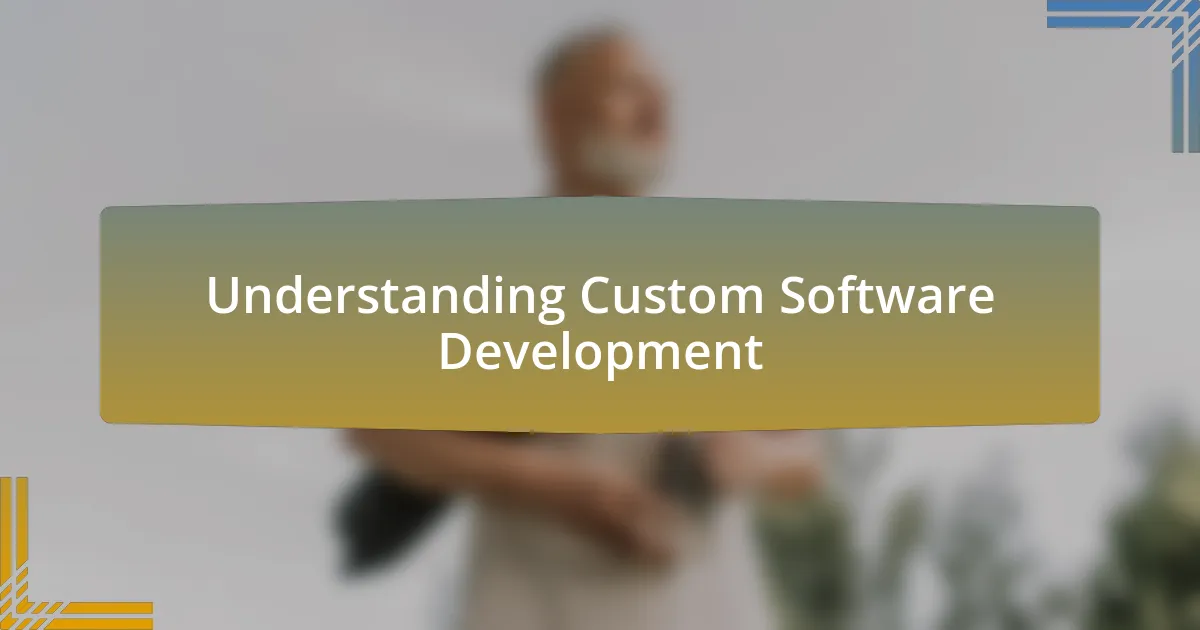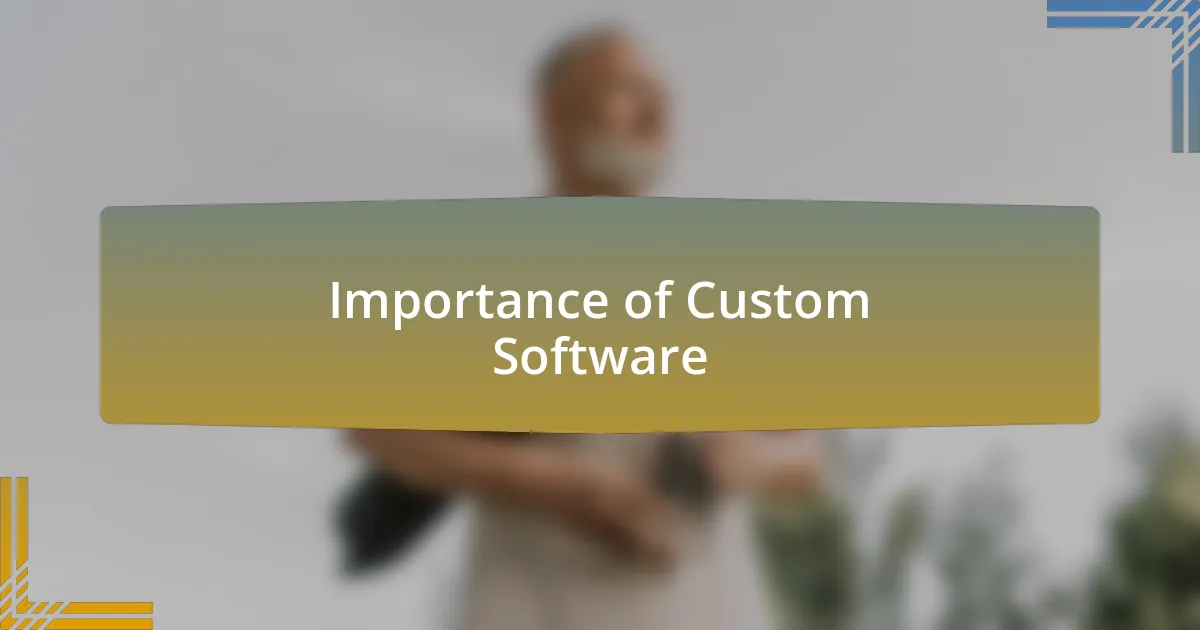Key takeaways:
- Custom software development tailors solutions to specific organizational needs, enhancing operational efficiency and user satisfaction.
- Key features of effective software include user-friendliness, customization, and strong security to foster trust and engagement.
- Clear communication and flexibility are crucial in the development process, as they prevent misunderstandings and allow for necessary adjustments.
- Prioritizing user feedback drives software improvement and fosters a sense of community among users.

Understanding Custom Software Development
Custom software development is the process of creating software solutions tailored specifically to meet the unique needs of a business or organization. I remember when I first encountered a software solution that was designed just for my team; it was like finding the perfect puzzle piece that fit flawlessly. This experience made me realize how important it is to have software that aligns not just with what you do, but also with how you do it.
As I delved deeper into custom software, I often found myself asking: what truly makes it different from off-the-shelf solutions? The answer lies in its adaptability. Unlike generic software, custom solutions are flexible and can be modified as your needs evolve. For instance, when I saw a retirement home streamline their operations with a unique scheduling system, the impact was clear—efficiency skyrocketed, and residents were happier.
Moreover, there’s an emotional aspect that I think is crucial—custom software often reflects the values and culture of an organization. During a discussion with a developer, I learned how they craft software with the end-users in mind, ensuring it resonates with not just the staff but also the clients they serve. This connection transforms software from a mere tool into a vital part of the community fabric. Looking back, those experiences shaped my understanding that investing in custom software is not just a business decision; it fosters a sense of belonging and commitment.

Importance of Custom Software
Custom software serves as a critical backbone for any organization, particularly in environments like luxury retirement homes where personalized service is paramount. I recall a time when a custom feedback system was implemented in a community I observed, allowing residents and their families to share their thoughts directly. The result was not just higher satisfaction rates, but a genuine feeling of being heard and valued—an essential element in creating a nurturing environment.
Another aspect that I find fascinating is how custom software can dramatically enhance day-to-day operations. When I witnessed a bespoke inventory management system being introduced, I saw firsthand how it eliminated waste and improved accessibility to resources for staff. This direct correlation between technological solutions and the quality of care truly opened my eyes to how critical it is to invest in tailored software that meets specific needs.
Reflecting on the importance of custom software, I often wonder: how different could organizations be if they used technology designed specifically for them? My experiences suggest that when software evolves alongside an organization, it fosters innovation rather than stagnation. This evolution not only enhances internal processes but ensures that the resident experience is always at the forefront, adapting to their needs as they change.

Exploring Luxury Retirement Homes
Exploring luxury retirement homes often reveals a blend of comfort and sophistication. I remember visiting a particularly upscale community where each room was designed not just for utility but for enhancing the overall experience of living. It struck me how important aesthetics and environment are; it’s about creating a space that feels like home while offering a luxurious escape.
As I walked through the beautifully landscaped gardens, I noticed residents engaging in various activities tailored to their interests. This personalized approach makes a world of difference. When I think about it, why wouldn’t someone want to wake up each day knowing there are curated experiences waiting for them? It’s this emphasis on individual preferences that positions luxury retirement homes as havens of joy and fulfillment.
The amenities in these residences often extend beyond mere luxury. I recall a community that offered personalized culinary experiences, where residents could choose from a wide range of gourmet meals. This not only catered to their tastes but enhanced their sense of autonomy. Isn’t it fascinating how the blend of luxury and personalization transforms a simple living arrangement into a vibrant community?

Key Features of Effective Software
One essential feature of effective software is user-friendliness. I remember working with a system that initially seemed daunting, filled with options that felt endless. However, once I got the hang of it, the intuitive design made navigating through tasks a breeze. Isn’t it interesting how a streamlined user interface can drastically enhance productivity? It creates a sense of confidence, allowing users to engage with the software without frustration.
Another key feature is customization. In my experience, software that can be tailored to specific needs can make all the difference. I once collaborated on a project where we adapted features based on user feedback, leading to increased satisfaction and engagement. The ability to adjust settings or workflows not only empowers users but creates a personal connection with the tool they’re using. Have you ever felt a sense of ownership with software that fits your unique preferences perfectly?
Lastly, robust security is paramount. I’ve witnessed firsthand the anxiety that accompanies data breaches or privacy concerns. Working on a platform that prioritizes security features gave me peace of mind. It’s reassuring to know that sensitive information is protected, fostering trust between users and the software. After all, what good is a fantastic tool if you can’t feel safe while using it?

Lessons Learned from My Journey
One major lesson I learned is the significance of clear communication during the development process. I remember a time when a misunderstanding about project requirements led to rework and frustration on both sides. It made me realize that fostering an open dialogue right from the start can save not only time but also emotional energy for everyone involved. Have you ever been stuck in a situation like that, where clarity could have transformed the outcome?
Another insight I gained is the importance of embracing flexibility. Early on, I was rigid in my approach, sticking to initial plans without considering necessary adjustments. However, I discovered that being open to change allowed the software to evolve alongside user needs. This adaptability not only enhanced the project’s relevance but also created a more enjoyable experience for everyone. Can you recall a moment when adapting to change led you to a better solution?
Lastly, prioritizing user feedback became a cornerstone of my software development experience. I once launched a feature with high expectations, only to find it didn’t resonate with users. This was eye-opening; it emphasized the need to listen and iterate based on real-world usage. Engaging with end-users not only results in a better product but also fosters a sense of community, which feels incredibly fulfilling. How do you approach feedback, and what lessons have you drawn from it?